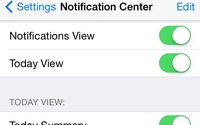Commentary
Mobile Notifications Pretty Much OK for 73% of Consumers
- by Chuck Martin , Staff Writer, July 24, 2014
 That mobile tap on the shoulder to check something out is quite
accepted by consumers, for now.
That mobile tap on the shoulder to check something out is quite
accepted by consumers, for now.
At the moment, most smartphone owners are basically OK with notifications prompted by an app, though there could be some challenge on the horizon, based on a new study.
The research is included within a new quarterly publication called Next, just being launched by GroupM, a unit of WPP, and the first issue centers around mobility.
The publication, in the form of a new website, includes comprehensive, detailed reports, such as one naming 10 companies it sees shaping the mobile future, a 20-year forecast of the mobile world and an interactive quiz for companies and individuals to see what their mobile brand looks like.
“It’s a chance to go long-form,” GroupM Next CEO Chris Copeland told me yesterday. “The goal is to blend first-party data to paint as full a picture as we can.”
From a mobile commerce perspective, the aspect that caught my eye was the featured mobile report “A Mobile Shopping Revolution,” which includes new research conducted by GroupM Next.
The study looked at app notifications in light of the coming explosive deployment of beacons and analyzed the relationship between purchase behavior and smartphone activity.
Most consumers are somewhat accepting of those notifications they receive when opening an app, according to the GroupM Next survey of 1,000 smartphone owners.
Most smartphone owners usually or at least sometimes allow notifications when prompted by an app.
- 31% -- Usually allow notifications
- 42% -- Sometimes allow notifications, depending on the app
- 27% -- Usually do not allow notifications
But not all consumers want to receive notifications all the time. Here’s why:
- 34% -- Get too many notifications already
- 22% -- Notifications from that app are not helpful
- 16% -- Come at inconvenient times
- 14% -- Too similar to text message noises/vibrations
- 14% -- Too hard to turn off once allowed
And that’s the potential issue of the future. The top reason for declining notifications is that consumers already feel they get too many. And this is before the mass deployment of beacons in stores.
“There is a huge battleground going forward,” said Jesse Wolfersberger, director of consumer insights at GroupM Next and leader of the study. “It’s so easy for customers to turn notifications off.”
The challenge for marketers will be to deliver compelling value, such as in the form of coupons or discounts, so that consumers agree to accept notifications.
“There will be a high bar to clear for relevancy,” says Wolfersberger. “It’s not about just showing ads.”
With the coming world of beacons, the options for notifications will only increase.
“These beacons are decisions points,” says Wolfersberger, who will be participating in the in-depth discussion on beacons at the upcoming MediaPost OMMA mCommerce conference.
That split second a consumer has to decide whether or not to allow notifications from a particular app can determine if, when and how much a brand will interact with that mobile shopper.
That’s serious momentary marketing.
Beacons, targeting and all the other major issues relating to mobile commerce will be discussed at the MediaPost OMMA mCommerce conference in New York on Aug. 7. You can check out the agenda where you also can register to attend. Will I see you there?




Excellent article Chuck. I suspect the abuse of In App messaging or Push Notifications in general will lead to a significant drop off in acceptance if marketers don't quickly embrace the idea of true personalization versus generic blasts or even simple segmentation. Beware of beacon technology if you're not prepared to treat mobile customers with relevant, thus personalized messages, promotions and/or offers. Enjoy your initial lift then watch participation and acceptance plummet. Wolfersberger is spot on about relevancy and while most marketers will nod their heads in violent agreement, very few understand how to achieve true personalization across all mobile touch points. It can be done today, but requires the right technology partner and the will inside marketing organizations to climb that hill. Early adopters won't automatically win. But the ones who get it right will gain a huge first mover advantage.
While the general point of this is absolutely true (marketers must deliver relevant and personal communication), the headline is a bit off. The data around opt-ins to push notifications stand in stark contrast to the survey data. If you talk with the leading push platforms, they'll tell you that ~45% of consumers opt in to push today and that's on the decline. So, while most customers might say they're open to it, their actions are demonstrating that it's tough to even get half of your audience to want to hear from you via push.
Thanks very much, Kurt. Good point about the anticipated drop-off if not done right. This one may take some time to sort out for consumers.
Thanks for your comment, Robi, though the headline is based on the survey conducted and associated results. The push platforms may have differing data, as you suggest, though the results of this consumer survey by GroupM Next is in line with other consumer studies.